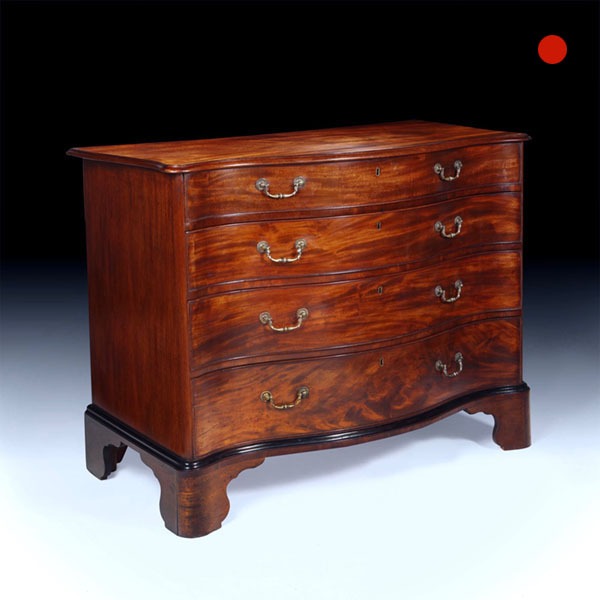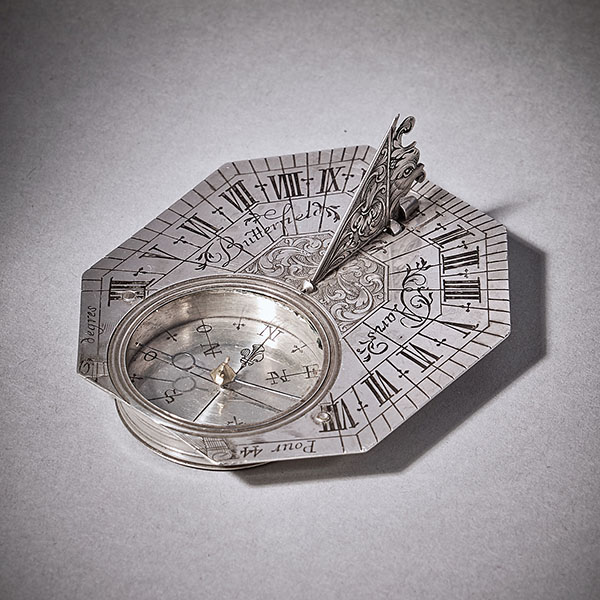A Rare and Important Charles II 17th Century Table Clock by Henry Jones
£85,000
Follow Us
A Rare and Important Charles II 17th Century Table Clock by Henry Jones
The Rare and Important 17th Century Spring Driven Table Clock by the Celebrated Maker, Henry Jones.
Provenance dating back to 1745. Owned by Captain Alexander Raitt
A very rare and unusual Charles II English eight-day spring-driven table clock signed on the backplate, Henry Jones in the Temple, dating back to the period c.1675-80.
The elegantly proportioned ebony-veneered oak basket top case, whose austerity goes straight back to East-style models, has extremely shallow mouldings and large rectangular viewing windows to the sides so that the movement is almost entirely visible. The case rests on four brass bun feet.
The fine square brass dial with matted centre and just winding holes has an applied silvered chapter ring and winged cherub-head spandrels in the corners. The chapter ring is engraved with a narrow outer minute ring within which are Arabic five-minute numerals and two different types of 7½-minute markers, a central ring with Roman hours I-XII and fleur-de-lys half-hour markers and an inner ring divided into quarter hours. The time is indicated by an elegant pair of finely pierced period blued steel hands. Above the XII is a strike/silent aperture with original switch.
The striking eight-day twin fusee brass movement, with six latched pillars, early fusees with open click work and verge escapement with a short knife-suspended pendulum. The striking, which is regulated by an internal rack, indicates the hours fully on a bell. The backplate shows the pre-setting ratchet wheels with typical clicks and a fine U-shaped click spring. It is profusely engraved in period style around a typical signature cartouche with the maker’s name: Henry Jones in the Temple. The movement has an unusual bar operated pull-quarter repeat on two bells differing in pitch, one for the quarters and the other the hour bell.
The maker
Henry Jones was born at Boulder near Southampton in 1634 and was apprenticed to the famous maker Edward East in 1654 through the Clockmakers’ Company. He was made free in 1663 but remained working for East until 1672, when he set up in the Inner Temple. Later he was recorded in the Inner Temple Lane. He was a prolific maker, his work being highly thought of. Apart from spring, lantern and longcase clocks, he also made watches.
Condition
Good. Repaired. Replacements made. Wear consistent with age and use. The repeat work was partly restored to the original pattern. Several missing parts were made in the correct style.
Dimensions
Height: 12.6 in (32 cm)
Width: 9.06 in (23 cm)
Depth: 5.91 in (15 cm)
Literature
B. Loomes, The Clockmakers of Great Britain 1286-1700, Ashbourne, 2014, pp.430-31.
B. Loomes, Watchmakers and clockmakers of the World, London, 2006, p.429.
Provenance
This clock is known as the Alexander Raitt clock. It was shipped from Scotland to America by Captain Alexander Raitt in 1745, sailing his own ship. Captain Raitt settled in Kittery in the province of Maine of the Massachusetts Bay Colony. On October 2, 1747, he married Miriam Frost (1722-1807), widow of Eliot Frost, a daughter of the Honourable John Frost of New Castle, New Hampshire.
The house where the Raitts lived is still in a good state of preservation in Kittery, now Eliot. It was built by Eliot Frost, Miriam’s first husband in 1740.
The clock, descending from father to son since it was brought over from Scotland and has been in the Raitt family until it was acquired by Miss Elizabeth Mehitable Bartlett of Eliot who presented it to her brother Ralph Sylvester Bartlett in 1939. It was still in his possession in 1941. It later went to his cousin John William Pepperrel Frost, who was the last owner, before we acquired the clock.
PREVIOUSLY SOLD

George I Gilt Gesso Mirror
IMPORTANT DESIGN – A fine early 18th-century gilt gesso mirror of generous proportions retaining its original shaped and bevelled mirror plate. The frame expresses great freedom through its carving with scrolling leaves adorning the frame centred by an elaborate three-dimensional cartouche.

George III Mahogany Wine Cooler, Cellarette
Superb George III mahogany wine cooler or cellarette on stand. The cellarette is in fabulous original condition with a lovely rich patina. Lovely well-patinated flame of mahogany to the top, with a line rope inlayed stringing of holly and box. Original led lined interior divided into four sections.

George I Carved Irish Walnut Pair of Chairs
A rare and fine pair of Irish George I walnut side chairs of excellent colour and patina, circa 1720. The undercut shaped back-splats of violin form are beautifully and naturally carved in acanthus leaves, returning into eared scrolls, topped by a crest rail depicting curtain swags and fine hanging passementerie.

George III Parcel Gilt Painted Pair of Chairs
A fine pair of painted and carved George III English chairs in the French taste, upholstered in silk damask.
Possibly by John Linnell.

George III Mahogany Serpentine Chest of Drawers
Dating from one of the most famous and highly celebrated periods in English furniture history, now known as the ‘Chippendale period’.
This fine George III mahogany serpentine chest is very much in the manner of Thomas Chippendale.

17th-Century Beadwork/Stumpwork Japanned Mirror
Advances in English domestic glass production in the second half of the century coincided with the fashion for stumpwork and resulted in the production of some of the most spectacular examples being produced.

George I Gilt Gesso Mirror
IMPORTANT DESIGN – A fine early 18th-century gilt gesso mirror of generous proportions retaining its original shaped and bevelled mirror plate. The frame expresses great freedom through its carving with scrolling leaves adorning the frame centred by an elaborate three-dimensional cartouche.

George III Mahogany Wine Cooler, Cellarette
Superb George III mahogany wine cooler or cellarette on stand. The cellarette is in fabulous original condition with a lovely rich patina. Lovely well-patinated flame of mahogany to the top, with a line rope inlayed stringing of holly and box. Original led lined interior divided into four sections.

George I Carved Irish Walnut Pair of Chairs
A rare and fine pair of Irish George I walnut side chairs of excellent colour and patina, circa 1720. The undercut shaped back-splats of violin form are beautifully and naturally carved in acanthus leaves, returning into eared scrolls, topped by a crest rail depicting curtain swags and fine hanging passementerie.

George III Parcel Gilt Painted Pair of Chairs
A fine pair of painted and carved George III English chairs in the French taste, upholstered in silk damask.
Possibly by John Linnell.

George III Mahogany Serpentine Chest of Drawers
Dating from one of the most famous and highly celebrated periods in English furniture history, now known as the ‘Chippendale period’.
This fine George III mahogany serpentine chest is very much in the manner of Thomas Chippendale.

17th-Century Beadwork/Stumpwork Japanned Mirror
Advances in English domestic glass production in the second half of the century coincided with the fashion for stumpwork and resulted in the production of some of the most spectacular examples being produced.
YOU MAY ALSO LIKE

18th Century Japanned Chinoiserie Dome-Topped Box, Circa 1715-1725
18th Century Japanned Chinoiserie Dome-Topped Box, Circa 1715-1725 £3,800Follow Us18th Century Japanned Chinoiserie Dome-Topped Box, Circa 1715-1725 Early 18th century George I Japanned Chinoiserie dome-topped box, Circa 1715-1725. England or...

Magnificent 18th Century Striking Dutch Amsterdam Burl Walnut Longcase Clock
Magnificent 18th Century Striking Dutch Amsterdam Burl Walnut Longcase Clock £26,000Follow UsMagnificent 18th Century Striking Dutch Amsterdam Burl Walnut Longcase Clock An impressive Dutch longcase clock with a burr walnut veneered oak case,...

18th Century George III Mahogany Wine Cooler or Cellarette
18th Century George III Mahogany Wine Cooler or Cellarette £4,600Follow Us18th Century George III Mahogany Wine Cooler or Cellarette A fine and well-figured George III mahogany hexagonal wine cooler or cellarette on the original stand, C....

Striking 19th Century Carriage Clock with a Gilt-Brass Corniche Case by Grohé
Striking 19th Century Carriage Clock with a Gilt-Brass Corniche Case by Grohé £3,995 Follow UsStriking 19th Century Carriage Clock with a Gilt-Brass Corniche Case by Grohé Striking carriage clock with a gilt-brass corniche case by Grohé,...

Rare Silver Pocket Sundial and Compass by Michael Butterfield, Paris, circa 1700
Rare Silver Pocket Sundial and Compass by Michael Butterfield, Paris, circa 1700 £4,900 Follow UsRare Silver Pocket Sundial and Compass by Michael Butterfield, Paris, circa 1700 A beautiful, rare solid silver Anglo-French octagonal pocket...

Engraved Eight-Day Striking and Repeating Carriage Clock by Perregaux Au Locle
Engraved Eight-Day Striking and Repeating Carriage Clock by Perregaux Au Locle Follow UsEngraved Eight-Day Striking and Repeating Carriage Clock by Perregaux Au Locle The superb engraved gilt gorge brass case has facetted glass panels to all...

18th Century Japanned Chinoiserie Dome-Topped Box, Circa 1715-1725
18th Century Japanned Chinoiserie Dome-Topped Box, Circa 1715-1725 £3,800Follow Us18th Century Japanned Chinoiserie Dome-Topped Box, Circa 1715-1725 Early 18th century George I Japanned Chinoiserie dome-topped box, Circa 1715-1725. England or...

Magnificent 18th Century Striking Dutch Amsterdam Burl Walnut Longcase Clock
Magnificent 18th Century Striking Dutch Amsterdam Burl Walnut Longcase Clock £26,000Follow UsMagnificent 18th Century Striking Dutch Amsterdam Burl Walnut Longcase Clock An impressive Dutch longcase clock with a burr walnut veneered oak case,...

18th Century George III Mahogany Wine Cooler or Cellarette
18th Century George III Mahogany Wine Cooler or Cellarette £4,600Follow Us18th Century George III Mahogany Wine Cooler or Cellarette A fine and well-figured George III mahogany hexagonal wine cooler or cellarette on the original stand, C....

Striking 19th Century Carriage Clock with a Gilt-Brass Corniche Case by Grohé
Striking 19th Century Carriage Clock with a Gilt-Brass Corniche Case by Grohé £3,995 Follow UsStriking 19th Century Carriage Clock with a Gilt-Brass Corniche Case by Grohé Striking carriage clock with a gilt-brass corniche case by Grohé,...

Rare Silver Pocket Sundial and Compass by Michael Butterfield, Paris, circa 1700
Rare Silver Pocket Sundial and Compass by Michael Butterfield, Paris, circa 1700 £4,900 Follow UsRare Silver Pocket Sundial and Compass by Michael Butterfield, Paris, circa 1700 A beautiful, rare solid silver Anglo-French octagonal pocket...

Engraved Eight-Day Striking and Repeating Carriage Clock by Perregaux Au Locle
Engraved Eight-Day Striking and Repeating Carriage Clock by Perregaux Au Locle Follow UsEngraved Eight-Day Striking and Repeating Carriage Clock by Perregaux Au Locle The superb engraved gilt gorge brass case has facetted glass panels to all...













